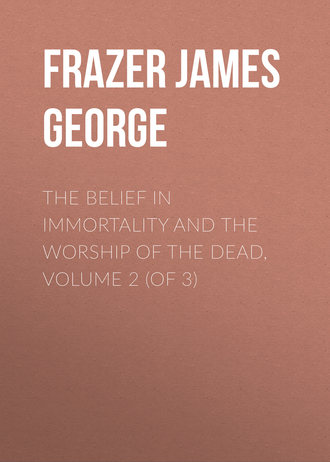 полная версия
полная версияThe Belief in Immortality and the Worship of the Dead, Volume 2 (of 3)
Some thirty years later the tombs of the Tooitongas were visited and described by the French explorer, J. Dumont d'Urville. His description is worth quoting. He says: "I directed my steps to the splendid faï-tokas of the Fata-Faïs. As these monuments are essentially taboo, in the absence of the Tooi-tonga no one looks after their upkeep, and they are now buried on every side among dark masses of trees and almost impenetrable thickets. Hence we had some difficulty in approaching them, and it was impossible for us to get a single general view of the whole of these structures, which must have a somewhat solemn effect when the ground is properly cleared.
"For the most part these mausoleums have the form of great rectangular spaces surrounded by enormous blocks of stone, of which some are as much as from fifteen to twenty feet long by six or eight broad and two feet thick. The most sumptuous of these monuments have four or five rows of steps, making up a total height of eighteen or twenty feet. The interior is filled up with shingle and fragments of unhewn coral. One of these faï-tokas, which I measured, was a hundred and eighty feet long by a hundred and twenty broad. At one of the upper angles I observed a block of considerable size with a deep cutting in it. I was told that it was the seat of the Tooi-tonga-fafine280; it was there that she sat to preside at the ceremony of the funeral of the Tooi-tonga.
"Some of these edifices were of an oval form, but they were much smaller. Each of them was surmounted by a small hut, which served as an oratory or house for the spirit of the dead; most of them have been destroyed by the lapse of time, and only traces of them are left scattered on the ground.
"The enormous blocks of coral employed in the construction of these monuments have all been brought by sea from Hifo to Mooa. They were got on the shore of the sea at Hifo, were hewn on the spot, and were transported in great canoes; then they were landed at Mooa and drawn on rollers to the place of their destination. These monuments are astonishing evidence of the patience which they must have demanded on the part of these islanders; they were ocular testimony to me of the high degree of civilisation which the natives had reached. Man must have risen to ideas of a much higher order than those of a simple savage before he would take so great pains for the single object of consecrating the memory of his chiefs.
"Such tombs are no longer built in Tongataboo: people content themselves with simple mounds surrounded by a row of posts or even an ordinary palisade. However, Singleton assured me that Finow the Younger had erected two great faï-tokas of stone in Vavao, one for the last Tooitonga, and one for his father."281
The Frenchman, De Sainson, who accompanied Dumont d'Urville on his visit to Tongataboo, has also described the tombs of the Tooitongas at Mooa from personal observation. I will quote his description: "It is in the heart of the forest that the ancient inhabitants of these countries, who idolized their Kings (Tooi-tongas), placed the tombs of that sacred race. These monuments of a more enterprising age still astonish the beholder by their mass and their extent. The fai-tokas, as these burial-places are called, are artificial eminences, on the top of which, in the form of a square, are three or four crosses of great granitic blocks arranged as steps, of which each block may be four or five feet high. If there is only a single step on the top of the mound, it is because only a single Tooi-tonga sleeps there in the grave; if the bones of a whole family are deposited in a common tomb, three or four steps, one above the other, mark their union in death. Some of these monuments which contain only a single body are arranged in an oval. I counted more than twelve of these immense structures, and yet we left a great many aside. I counted more than one stone between eight and fifteen feet long; and I conceived a high idea of those men of ancient days who erected over the remains of their kings these imperishable mausoleums, in an island based on coral, where it would be difficult to find a stone of two feet square. I imagined them to be very different from their effeminate descendants, those men of old who went in their canoes more than a hundred and fifty leagues to look for the enormous blocks of which these tombs are built, who cut them without the help of iron, and succeeded, by means unknown, in planting them on these hillocks, where by their own weight they are fixed for ever, like the Druidical monuments of Brittany, which one would say were dropped on earth rather by the magic of talismans than by the power of man.
"The present inhabitants of Tonga contemplate with a pious awe the fruit of the labours and patience of their forefathers, without dreaming for a moment of imitating them in their noble enterprises. A distant voyage affrights these degenerate scions of a hardy race, and the great canoes which still survive, sheltered under sheds very skilfully built, are little more than the useless encumbrance of chiefs grown languid in the long peace which has infected the whole people with habits of indolence.
"The most recent tombs consist of a small house enclosed on all sides, built on a rising ground, and shaded by a circle of mimosas, a tree sacred to the dead. Most of the illustrious graves are clustered together at Mafanga, a large village of which the whole territory is sacred on account of the hallowed relics which it contains. Along with the corpse they bury at the depth of a few inches small wooden effigies representing persons of both sexes. I had occasion to unearth a few of these little statues, and I remarked in them an astonishing feeling for artistic design."282
Some sixteen years later a Catholic missionary, living among the heathen population of Tongataboo, wrote thus: "Nothing equals the care which they take in the burial of their dead. As soon as a native has breathed his last, the neighbours are informed, and immediately all the women come to weep about the corpse. Here the men never weep. The body is kept thus for a day or two, during which they are busy building a tomb near the dwelling of the deceased's family. The sepulchral house is neat, built on an eminence, surrounded by a pretty fence of choice bamboos; the enclosure is planted with all kinds of odoriferous shrubs, especially evergreens. Finally, the monument is covered by a roof artistically constructed. For the tombs of kings and the greatest chiefs they go to distant islands to find huge stones to crown the grave. I have seen one twenty-four feet long by eight broad and at least eighteen inches thick. One of these tombs was built by the natives of Wallis Island, who brought the enormous blocks in immense canoes. It is wonderful for these peoples."283
Captain Erskine, who visited Tongataboo in 1849, says that "near the landing-place at the village of Holobeka, off which we were lying, we saw overshadowed with trees, one of the faitokas, or old burial-places of the country, which, although no longer 'tabu,' are still in some cases used as places of sepulture, and very carefully kept. This one was an oblong square platform a few feet high, surrounded by a stone wall, the interior being beautifully paved with coloured corals and gravel; the house or temple, which Captain Cook and others describe as occupying the centre, having been, I suppose, removed. I saw but one other of these monuments during our stay among the islands, the largest of which stands on several rows of steps, as described by all former visitors."284
Thomas West, who lived as a missionary in the Tongan islands from 1846 to 1855, tells us that "chiefs were usually interred in tombs, constructed of blocks of sandstone, cut from suitable localities by the seashore, where, at a little depth from the surface, layers of hard and durable sandstone are found, even on many of the coralline islands. In several of the ancient burial-places, similar stones, arranged in terraces, surround the whole enclosure. Some of these are of immense size, and seem to indicate the possession, on the part of former inhabitants, either of greater energy than the present race, or of better tools and appliances. The burial-places of the Tonguese are always surrounded by the most imposing foliage of the tropics, and placed in sequestered spots. A mound of earth is raised, of dimensions varying with the necessities of the place; and, whenever a grave is opened within the limits of this mound, it is always filled up with beautiful white sand, and never contains more than one body. No particle of clay or earthy mould is allowed to touch the remains of the dead. The sand is brought in baskets by the chief mourners, who sometimes sail or journey many miles to procure it; and each person pours the contents into the grave until it is sufficiently filled up. The top of the grave is, afterwards, carefully tended and decorated with black pebbles and red coral, arranged in various devices, which have a very pretty effect. Small houses are also placed over the tombs of the chiefs and gentry."285
In more recent years the tombs of the Tooitongas at Mooa have been visited by Sir Basil Thomson, who has described and discussed them.286 From an anonymous pamphlet called The Wairarapa Wilderness, written by the passengers of the s.s. Wairarapa and published in 1884, Sir Basil Thomson quotes a passage containing a description of the tombs, with measurements which, he tells us, are accurate as far as they go. From it I will extract a few particulars. The writers inform us that the tombs are built of blocks of coral which vary in length and thickness; some of the largest they found to be from fifteen to eighteen feet long and from one and a half to two feet thick. The largest measured by them is twenty-two feet long and two feet thick and stands between seven and eight feet above the ground. This great stone, now split in two, is at the middle of the lowest step of one of the pyramidal tombs. The height of the steps varies much in the different pyramids; one step was found to be four feet high. The breadth of each step is three feet or more: it has been carefully levelled and covered with coral gravel. The stones fit very closely and are very regular at top and bottom throughout the tiers. The corners of one pyramid observed by the writers are formed of huge rectangular stones, which seem to have been put in position before they were finally faced. On the upper surface of the largest stone is a deep hollow about the size and shape of a large chestnut mortar. Sir Basil Thomson, who has examined this hollow, believes it to be a natural cavity which has been artificially smoothed by a workman. He suggests that it may have been lined with leaves and used as a bowl for brewing kava at the funeral ceremonies. On one mound the writers of the pamphlet remarked a large flat stone, some five and a half feet square; and in several of the tombs they noticed huge slabs of volcanic stone placed indiscriminately side by side with blocks of coral. The writers measured the bases of three of the tombs and found them to be about two chains (one hundred and thirty-two feet) long by a chain and a half (ninety-nine feet) broad; the base of a fourth was even larger.287
Surveying these various accounts of the tombs of the Tooitongas or sacred chiefs, we may perhaps conclude that, while the type of tomb varied in different cases, the most characteristic, and certainly the most remarkable, type was that of a stepped or terraced pyramid built of such large blocks of stone as to merit the name of megalithic monuments. So far as I have observed in the accounts given of them, this type of tomb was reserved exclusively for the sacred chiefs, the Tooitongas, whom the Tongans regarded as divine and as direct descendants of the gods. The civil kings, so far as appears, were not buried in these massive pyramids, but merely in stone vaults sunk in the summits of grassy mounds.
It is natural, with Sir Basil Thomson,288 to compare the pyramids of the Tooitongas with the similar structures called morais or marais which are found in Tahiti and the Marquesas islands. Indeed, the very name morai was sometimes applied to them by the Tongans themselves, though more usually they called them fiatookas, which was simply the common word for burying-ground.289 In Tahiti and the Marquesas islands these marais were in like manner truncated pyramids, rising in a series of steps or tiers, built of stones, some of which were large, but apparently not so large as in the corresponding Tongan edifices; for in describing one of the largest of the Tahitian morais or marais Cook mentions only one stone measuring as much as four feet seven inches in length by two feet four in breadth, though he found several three and a half feet long by two and a half feet broad. These dimensions can hardly compare with the size of the blocks in the tombs of the Tooitongas, some of which, as we have seen, measure fifteen, eighteen, and even twenty-two or twenty-four feet in length by eight or twelve feet in height. These Tahitian and Marquesan pyramids are commonly described as temples, and justly so, because the gods were worshipped there and human sacrifices were offered on them.290 But they were also, like the similar structures in Tonga, used in certain cases for the burial of the dead, or at all events for the preservation of their embalmed bodies. Captain Cook seems even to have regarded the Tahitian morais primarily as burying-grounds and only secondarily as places of worship.291 In the island of Huahine, one of the Society Islands, the sovereign chiefs were buried in a marai, where they lay, we are told, in more than Oriental state.292 William Ellis, one of our best authorities on the religion of the Tahitians, tells us that "the family, district, or royal maraes were the general depositories of the bones of the departed, whose bodies had been embalmed, and whose skulls were sometimes preserved in the dwelling of the survivors. The marae or temple being sacred, and the bodies being under the guardianship of the gods, were in general considered secure when deposited there. This was not, however, always the case; and in times of war, the victors sometimes not only despoiled the temples of the vanquished, and bore away their idol, but robbed the sacred enclosure of the bones of celebrated individuals."293 Moerenhout, another good authority on the Tahitian religion, informs us that the marais which belonged to individuals often served as cemeteries and were only the more respected on that account; but he says that in the public marais almost the only persons buried were the human victims offered in sacrifice, and sometimes the priests, who were laid face downwards in the grave, for the curious reason that otherwise the gaze of the dead men would blight the trees and cause the fruit to fall to the ground.294
In the Marquesas islands the morais appear to have been also used occasionally or even regularly as burial-places. Langsdorff, one of our earliest authorities on these islands, speaks of a morai simply as a place of burial.295 He tells us that the mummified bodies of the dead were deposited on scaffolds in the morai or family burial-place, and that the people of neighbouring but hostile districts used to try to steal each other's dead from the morais, and deemed it a great triumph when they succeeded in the attempt. To defeat such attempts, when the inhabitants of a district expected to be attacked in force by their enemies, they were wont to remove their dead from the morai and bury them in the neighbourhood.296 Again, in their monograph on the Marquesas islands, the French writers Vincendon-Dumoulin and Desgraz recognise only the mortuary aspect of the morais. They say: "The morais, funeral monuments where the bodies are deposited, are set up on a platform of stone, which is the base of all Nukahivan constructions. They are to be found scattered in the whole extent of the valleys; no particular condition seems to be required in the choice of the site. Near the shore of Taïohae is the morai which contains the remains of a brother of the atepeïou Patini, an uncle of Moana, who died some years ago, as they tell us."297
Thus to some extent, in function as well as in form, these pyramidical temples of Tahiti and the Marquesas islands corresponded to the megalithic monuments of the Tooitongas or sacred chiefs of Tonga; in fact, they were mausoleums as well as temples. We are not at liberty to assume, with one authority on the Polynesians, that they were mausoleums first and foremost, and that they only developed into temples at a later time.298 It is possible, on the contrary, that from the outset they were temples dedicated to the worship of the high gods, and that the custom of depositing the dead in them was a later practice adopted for the sake of the protection which these holy places might be expected to afford against the efforts of enemies to carry off and desecrate the remains of the departed. Dr. Rivers propounded a theory that the custom of building these megalithic monuments in the form of pyramids was introduced into the Pacific by a people who brought with them a secret worship of the sun, and he apparently inclined to regard the monuments themselves as at least associated with that worship.299 The theory can hardly apply to the megalithic monuments of the Tooitongas in Tongataboo; for the evidence which I have adduced seems to render it certain that these monuments were erected primarily as tombs to receive the bodies of the sacred chiefs. It is true that these tombs enjoyed a sacred character and were the scene of worship which justly entitles them to rank as temples; but so far as they were temples, they were devoted to the worship, not of the sun, but of the dead.
Thus our enquiry into the meaning and origin of these interesting monuments entirely confirms the view of the shrewd and observant Captain Cook that the fiatookas, as the Tongans called them, were both places of burial and places of worship.
Finally, the evidence which I have cited appears to render it highly probable that these imposing monuments were built, not by a prehistoric people, predecessors of the Tongans in the islands, but by the Tongans themselves; for not only do the people affirm that the tombs were erected by their ancestors, but they have definite traditions of some of the chiefs who built them, and are buried in them; and they still profess to remember some of the islands from which the huge stones were brought to Tongataboo in great double canoes.
That the graves of the great chiefs were, like temples, regarded by the people with religious reverence appears plainly from a statement of Mariner. He tells us that a place called Mafanga, in the western part of Tongataboo, being a piece of land about half a mile square, was consecrated ground. "In this spot," he says, "are the graves where the greatest chiefs from time immemorial have been buried, and the place is therefore considered sacred; it would be a sacrilege to fight here, and nobody can be prevented from landing: if the most inveterate enemies meet upon this ground, they must look upon each other as friends, under penalty of the displeasure of the gods, and consequently an untimely death, or some great misfortune. There are several of these consecrated places on different islands."300 Thus the reverence paid to the tombs of the chiefs was like the reverence paid to the consecrated houses and enclosures of the gods; we have already seen what a sacrilege it was deemed to fight or to pursue an enemy within the consecrated enclosure of a god,301 and we now learn that it was equally a sacrilege to fight within the ground that was hallowed by the graves of the chiefs.
Mariner has described for us the worship paid by the king and his chiefs to one of the sacred graves at Mafanga. One morning Finow the king, accompanied by several of his chiefs and their ministers (the matabooles), landed at Mafanga and immediately proceeded to his father's grave to perform a ceremony called toogi. Mariner attended the party and witnessed the ceremony. All who went to participate in it assumed the attire of mourners or suppliants, that is, they wore mats instead of their usual dress and they had wreaths, made of the leaves of the ifi tree, round their necks. They sat down before the grave, and the king and all of them beat their cheeks with their fists for about half a minute without speaking a word. One of the principal ministers (matabooles) then addressed the spirit of the king's father to the following effect: "Behold the man (meaning Finow, the king) who has come to Tonga to fight his enemies. Be pleased with him, and grant him thy protection. He comes to battle, hoping he is not doing wrong. He has always held Tooitonga in the highest respect, and has attended to all religious ceremonies with exactness." One of the attendants then went to the king and received from him a piece of kava root, which he laid down on the raised mount before the burial-place (fytoka). Several others, who had pieces of kava root in their bosoms, went up to the grave in like manner and deposited them there.302
Thus the king prayed to the spirit of his dead father at his grave and made an offering at the tomb. What more could he do to a god at his temple? And in general we are told that when a great blessing was desired, or a serious evil deprecated, if the people wished to enjoy health or beget children, to be successful at sea, or victorious in war, they would go to the burial grounds of their great chiefs, clean them up thoroughly, sprinkle the floor with sand, and lay down their offerings.303 When Finow the king was dying, his friends carried him on a bier, not only to the temples of the great gods Tali-y-Toobo and Tooi-fooa-Bolotoo, where prayers for his recovery were offered; they bore him also to the grave of a chieftainess and invoked her spirit in like manner to pity and spare the expiring monarch.304 Apparently they thought that the ghost of the chieftainess was quite as able as the great gods to heal the sick and restore the dying.
But on no occasion, perhaps, was the assimilation of dead men to gods so conspicuous as at the annual offering of first-fruits, which seems to have been the most impressive of all the yearly rites observed by the Tongans. The ceremony was observed once a year just before the yams in general had arrived at a state of maturity; the yams offered at it were of a kind which admitted of being planted sooner than the others, and which consequently, ripening earlier, were the first-fruits of the yam season. The object of the offering was to ensure the protection of the gods, that their favour might be extended to the welfare of the nation generally, and in particular to the productions of the earth, of which in Tonga yams are the most important. At this solemn ceremony the new yams, slung on poles, were brought from distant islands, carried in procession to the grave of the late Tooitonga, and deposited in front of it, their bearers sitting down beside them. Thereupon one of the ministers (matabooles) of the living Tooitonga arose, advanced, and sat down before the grave, a little in front of the men who had brought the yams. Next he addressed the gods generally, and afterwards particularly, mentioning the late Tooitonga and the names of several others. In doing so he returned thanks for their divine bounty in favouring the land with the prospect of a good harvest, and prayed that their beneficence might be continued in future. In this harvest thanksgiving the spirit of the dead Tooitonga seems to have ranked on an equality with the original or superhuman gods; indeed, in a sense he took precedence of them, since the offerings were presented at his grave. The first-fruits, we are told, were offered to the gods in the person of the divine chief Tooitonga.305
On the whole we may conclude that, however sharp a distinction was drawn in theory between the old gods, who had always been gods, and the new gods, who had once been men, the line which divided them in practice was wavering and blurred. The dead men and women were fast rising, if they had not already risen, to an equality with the ancient deities. We may even surmise that some of these old gods themselves were human beings, whose original humanity was forgotten.










